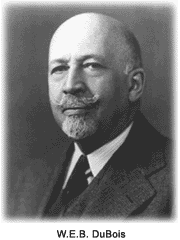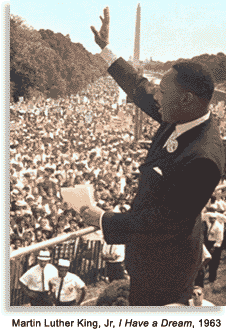The National Association for the Advancement of Colored People (NAACP) was founded in 1909 in New York City by a group of bi-racial activists. Originally called the National Negro Committee, it is the nation's oldest civil rights organization. One often-overlooked aspect of the NAACP's history is that the Jewish community contributed hugely to the NAACP's founding and continued financing.
 United in its opposition to the preaching of Booker T. Washington, who urged blacks to accept segregation, the NAACP first sought to make whites aware of the need for racial equality. The organization launched a program of speechmaking, lobbying, and publicizing the issue of racial discrimination and inequality in housing, education, employment, voting, and transportation. It also launched the Crisis, a magazine edited for 25 years by the black intellectual and leader, W.E.B. DuBois.
United in its opposition to the preaching of Booker T. Washington, who urged blacks to accept segregation, the NAACP first sought to make whites aware of the need for racial equality. The organization launched a program of speechmaking, lobbying, and publicizing the issue of racial discrimination and inequality in housing, education, employment, voting, and transportation. It also launched the Crisis, a magazine edited for 25 years by the black intellectual and leader, W.E.B. DuBois.
It appealed to the Supreme Court to rule as unconstitutional several laws passed by Southern states, and, beginning in 1915, won several important judgments regarding housing and voting rights.
In 1916, the NAACP began to expand its membership in the South, under the leadership of field secretary James Weldon Johnson, where the organization faced its most fierce opposition. By 1920, by which time Johnson became the first black executive secretary, membership had grown to 90,000, of which nearly half was in the South. The NAACP began to publicize the evils of the Jim Crow laws that sanctioned racial discrimination, and fought for a federal anti-lynching law.
In the 1920s and 1930s, the NAACP devoted much of its energy to publicizing the lynching of blacks throughout the United States. To show to the world that the members of the organization would not be intimidated, it held its 1920 annual conference in Atlanta, Georgia, considered at the time to be located in one of the most active Ku Klux Klan areas in the nation.
 In 1948, the NAACP pressured President Harry Truman into signing an Executive Order to ban discrimination by the federal government. In 1950, the NAACP began its campaign against the legal doctrine* that separate but equal schools for black and white children were constitutional. The Supreme Court had ruled that separate schools were acceptable as long as they were "separate but equal." The NAACP set out to prove that separate facilities provided to black students were not equal to those for whites. One study in 1937 revealed that school spending on pupils in the South was $37.87 per white pupil, compared to $13.08 per black pupil. Five desegregation lawsuits were launched in different states.
In 1948, the NAACP pressured President Harry Truman into signing an Executive Order to ban discrimination by the federal government. In 1950, the NAACP began its campaign against the legal doctrine* that separate but equal schools for black and white children were constitutional. The Supreme Court had ruled that separate schools were acceptable as long as they were "separate but equal." The NAACP set out to prove that separate facilities provided to black students were not equal to those for whites. One study in 1937 revealed that school spending on pupils in the South was $37.87 per white pupil, compared to $13.08 per black pupil. Five desegregation lawsuits were launched in different states.
The 1954 Supreme Court decision of Brown v. Board of Education of Topeka (Kansas) declared segregation in public schools to be unconstitutional. Most states accepted the ruling and began to desegregate, but others, notably in the deep South, refused to accept the court's decision. Orval Faubus, governor of Arkansas, used the state's National Guard to stop black children from attending the local high school in Little Rock. After 18 days of attempting to persuade the governor to obey the Supreme Court ruling, President Eisenhower sent in federal troops to ensure that black children could attend the school. Nine black students entered the building, then had to endure severe and constant physical and verbal abuse from their white classmates.
 In 1955, NAACP member Rosa Parks was arrested and fined for refusing to give up her seat to a white man on a segregated bus in Montgomery, Alabama. Following Parks' arrest, a local Baptist pastor, Martin Luther King Jr., helped to organize protests against bus segregation. He began to travel the country, make speeches and inspire people to become involved in what became known as the modern civil rights movement.
In 1955, NAACP member Rosa Parks was arrested and fined for refusing to give up her seat to a white man on a segregated bus in Montgomery, Alabama. Following Parks' arrest, a local Baptist pastor, Martin Luther King Jr., helped to organize protests against bus segregation. He began to travel the country, make speeches and inspire people to become involved in what became known as the modern civil rights movement.
The NAACP remained active nationally, both through its main organization and through its Legal Defense Fund. Rivalry among different civil rights groups was a continual problem within the movement, particularly among the leadership. Despite this, there also were numerous instances of cooperation and mutual support, most notably the March on Washington in 1963. The march was held as an attempt to persuade Congress to pass the Civil Rights Act. More than 200,000 people marched peacefully to the Lincoln Memorial to demand equal justice for all citizens under the law. At the end of the march, King made his famous "I Have a Dream" speech. He was assassinated just three months later.
Fifty-five years after the NAACP's founding, Congress passed the Civil Rights Act of 1964. The act made racial discrimination in public places illegal, and also required employers to provide equal employment opportunities. A year later, the Voting Rights Act was also passed, despite Southern lawmakers' resistance. The act, which states that no person shall be denied the right to vote on account of race or color, is generally considered to be the most successful piece of civil rights legislation ever adopted by Congress.
In the late 1970s, the NAACP broadened its scope by committing itself to the struggle for equal rights around the world.
Today, the NAACP is governed by a board of directors composed of people from around the U.S. They represent the Association's seven regions, youth councils, high school chapters, and college chapters. Headquarters are in Baltimore, Maryland. As of 2020, the NAACP had approximately 2 million members.